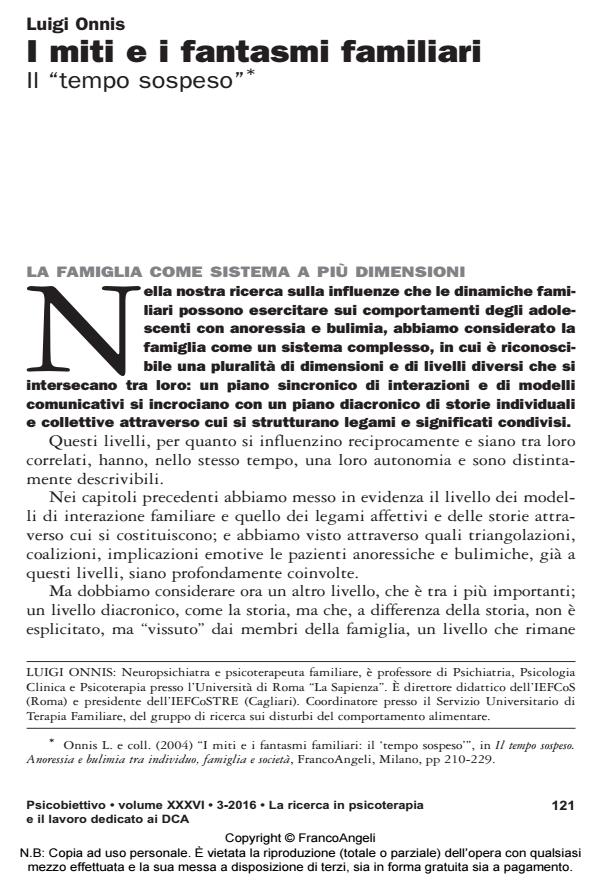Family myths and ghosts. The "suspended time"
Journal title PSICOBIETTIVO
Author/s Luigi Onnis
Publishing Year 2016 Issue 2016/3 Language Italian
Pages 22 P. 121-142 File size 134 KB
DOI 10.3280/PSOB2016-003008
DOI is like a bar code for intellectual property: to have more infomation
click here
Below, you can see the article first page
If you want to buy this article in PDF format, you can do it, following the instructions to buy download credits

FrancoAngeli is member of Publishers International Linking Association, Inc (PILA), a not-for-profit association which run the CrossRef service enabling links to and from online scholarly content.
This work is dedicated to the research in psychotherapy and in particular to eating disorders (DCA), it explores and describes the family as a complex system, in which a plurality of dimensions and different levels interconnected are recognizable: a synchronic level and communication pattern that intersect a diachronic level of individual and collective stories, through which bonds and shared meanings are built. This exploration of levels, through the concept of myth, brings out the special features and the meanings in the family. In particular, the research dedicated to anorexia and bulimia highlights the prerogatives of family myths related to such forms of suffering. Finally, in this work such myths are explored through the instrument of the - Family Time Sculptures -, presented in their theoretical assumptions and clinical practice presented in a case of DCA.
Keywords: Family as a Complex System; Diachronic Level; Synchronic Level; Family Myths; the Family Time Sculptures
- Boszormenyi-Nagy I., Spark G.M. (1988) Lealtà invisibili, Astrolabio, Roma
- Caillè P. (1990) Il rapporto famiglia-terapeuta, NIS, Roma
- Caillè P. (1991) Un et un font trois: la couple revelé a lui-même, ESF, Paris
- Caillè P., Rey Y. (1994) Les objets flottants, ESF, Paris
- Duhl F.J., Kanter D., Duhl B.S. (1973) “Learning space and action in family therapy: a primer of sculpture”, in Bloch D.A. (ed.), Techniques of family psychotherapy: a primer, Greene e Stratton, New York
- Ferreira A. (1963) “Family myth and homeastasis”, Arch. of General Psychiatry, 9: 186-197
- Ferreira A. (1966) “Psychosis and family myth”, American J. of Psychiatry, 29: 186-197
- Freud S. (1894) Le neuropsicosi da difesa (trad. it. in: Opere, vol. II, Boringhieri, Torino, 1968)
- Freud S. (1901) Frammenti di un’analisi di isteria (trad. it. in: Opere, vol. IV, Boringhieri, Torino, 1968)
- Green A. (1980) “Le Mythe: un objet transitionel collectif”, in Le temp de la reflexion, Gallinard, Paris
- Lotman J. (1980) “Retorica”, Enceclopedia Einaudi, vol. IX, Einaudi, Torino
- Neuburger R. (1994) Le mythe familiale, ESF, Paris
- Onnis L. (1994) “Sviluppi epistemologici della psicoterapia sistemica nella teoria e nella pratica”, in Onnis L. e Galluzzo W. (a cura di), La terapia relazionale e i suoi contesti, NIS, Roma
- Onnis L. (1996a) “La “narrazione analogica”: l’uso del linguaggio metaforico nella psicoterapia sistemica”, Psicobiettivo, 16, 3: 17-35
- Onnis L. (1996b) Les languages du corps, ESF, Paris
- Onnis L. (1997) La palabra del cuerpo, Herder, Barcelona, Buenos Aires
- Onnis L. e coll. (2000) “Quando il tempo è sospeso: individuo e famiglia nell’anoressia mentale”, Ecologia della Mente, 1: 11-25
- Onnis L., Di Gennaro A. (1987) “Alexitimia: una revisione critica”, Medicina Psicosomatica, 32, 1: 45-64
- Onnis L., Di Gennaro A., Cespa G., Agostini B., Chouhy A., Dentale R.C.,
- Quinzi P. (1990) “Le sculture del ‘presente’ e del ‘futuro’: un modello di lavoro terapeutico nelle situazioni psicosomatiche”, Ecologia della Mente, 10: 21-46
- Onnis L., Di Gennaro A., Cespa G., Agostini A., Chiuhy A., Dentale R.C., Quinzi P. (1994) “Sculpting present and future: a systemic intervention model applied to psychosomatic families”, Family Process, 33, 3: 341-355
- Onnis L., Laurent M., Benedetti P., Cespa G., Di Gennaro A., Dentale R.C.,
- De Tiberiis F., Forato F., Maurelli F.M. (1994c) “Il mito familiare: concetti teorici e implicazioni terapeutiche”, Ecologia della Mente, 2: 94-112
- Papp P. (1976) “Family choreography”, in P. Guerin (ed.), Family therapy: therapy and practice, Gardner Press, New York
- Ricoeur P. (1986) La metafora viva, Yaka Book, Milano
- Satir V. (1972) Peoplemaking, Science and Behavior Book, Palo Alto, CA
Luigi Onnis, I miti e i fantasmi familiari Il "tempo sospeso" in "PSICOBIETTIVO" 3/2016, pp 121-142, DOI: 10.3280/PSOB2016-003008